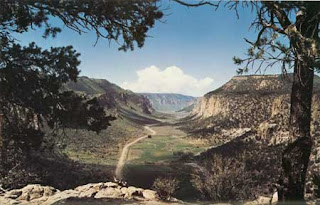 |
| Unaweep Canyon cuts across the Uncompahgre Plateau in western Colorado, USA. Courtesy ArcGIS Online; click to view. |
Unaweep Canyon cuts across the Uncompahgre Plateau in western Colorado roughly 15 air miles south of Grand Junction. At first glance, it looks like a superimposed or antecedent drainage, but there is a problem -- a river does not run through it. Instead, two creeks, East and West, run out of the canyon in opposite directions, with the divide between the two in the canyon bottom. In addition, East and West Creeks are underfit, i.e. they are too small to have carved a canyon so deep and so wide. Unaweep has puzzled humans for a long time -- its Ute Indian name means “dividing of waters” or “canyon with two mouths”.
One possible explanation is stream piracy: a large river used to run through the canyon, but was captured when headward erosion in a nearby drainage cut through. But which river? The mighty Colorado is an obvious choice; it flows in the same direction through the Grand Valley a short distance north. But no sediments diagnostic of the Colorado River have been found in Unaweep. There are deposits pointing to the Gunnison River, but only in the western part of the canyon.
 |
Unaweep Canyon looking southwest up East Creek from rim of inner gorge;
divide is just out of site in distance. Courtesy National Park Service.
|
The sediment record may suggest the Gunnison, but there is another question -- did the Gunnison River carve the canyon or did it exhume a buried landscape? Soreghan et al. (2007) argue the latter; they propose that Unaweep is a late Paleozoic glacial canyon. Numerous short amphitheater-like tributary drainages in the Precambrian inner gorge are suggestive of cirques. Pollen from late Paleozoic flora has been found in basal canyon fill exposed in road and stream cuts, as well as in samples from a well core. The authors suggest that the original glacial canyon was filled starting in late Paleozoic time. It was exhumed by the ancestral Gunnison River much later, during Neogene time (Miocene and Pliocene). Then the river was blocked, resulting in backfilling until the canyon was abandoned; the Gunnison now flows north to meet the Colorado.
Hood (2009) rejects the Paleozoic glacial valley scenario, and provides other possible explanations for the evidence presented by Soreghan et al. They, in turn, respond to each of Hood’s points, and stand by their hypothesis (Soreghan et al. 2009).
 |
| From Soreghan et al. 2007; note major fault at mouth of West Creek. |
 |
| Dolores River, west of the Uncompahgre Plateau. |
 |
| Unaweep Canyon is an easy day trip from Grand Junction, CO, USA. Courtesy Google Maps; click to view. |
[This post is part of a series devoted to upcoming field trips. I welcome suggestions
for other things to see and do in this area and sources of information.]
Sources
Chronic, Halka. 1980. Roadside geology of Colorado. Missoula MT: Mountain Press Publishing.
Update: I just found a 2nd edition (2002), coauthored with Felicie Williams. The treatment of Unaweep Canyon is unchanged from the first edition.
Update: I just found a 2nd edition (2002), coauthored with Felicie Williams. The treatment of Unaweep Canyon is unchanged from the first edition.
Hood, W. C. 2009. An exhumed Late Paleozoic canyon in the Rocky Mountains: a discussion. J. Geol. 117: 210–214. [response to Soreghan et al. 2007]
Soreghan, G. S.; Sweet, D. E.; Marra, K. R.; Eble, C. F.; Soreghan, M. J.; Elmore, R. D.; Kaplan, S. A.; and Blum, M. D. 2007. An exhumed late Paleozoic canyon in the Rocky Mountains. J. Geol. 115:473–481.
Soreghan, G. S.; Sweet, D. E.; Marra, K. R.; Eble, C. F.; Soreghan, M. J.; Elmore, R. D.; Kaplan, S. A.; and Blum, M. D. 2009. An exhumed late Paleozoic canyon in the Rocky Mountains: a reply. J. Geol. 115:473–481. [response to Hood 2009]
No comments:
Post a Comment